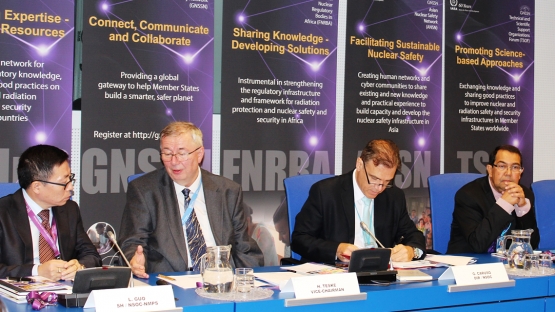Member States shared their experiences with implementing IAEA peer review missions in nuclear safety and security at a plenary meeting of the Global Nuclear Safety and Security Network (GNSSN) today. Peer review missions by an IAEA-led team of international experts assist Member States in enhancing their nuclear safety and security by providing recommendations and suggestions for improvement.
GNSSN is both a human network and a web platform, allowing its members to share nuclear safety and security knowledge services to further the goal of achieving worldwide implementation of a high level of nuclear safety and security. It promotes activities, including capacity building programmes and peer review missions, such as the International Protection Advisory Service (IPPAS) and the Integrated Regulatory Review Service Missions (IRRS).
“GNSSN has become one of the single most powerful mechanisms Member States have at their disposal to share nuclear safety and security knowledge, experience and good practices nationally, regionally and internationally,” said Gustavo Caruso, Director of the Office of Safety and Security Coordination at the IAEA.
Sharing Canada’s experience with an IPPAS mission, Philip Webster, Nuclear Safety Counsellor at the Permanent Mission of Canada to the United Nations in Vienna, said the mission had reviewed Canada’s regulatory regime for nuclear material and facilities, as well as the security arrangements applied to the transport of nuclear material, the security of radioactive material and the information and computer security systems in place.
He said the mission was an excellent opportunity for Canada to have its nuclear security program objectively evaluated by an IAEA-led international team of experts who provided valuable security recommendations, identified best practices and opportunities for learning and improvement.
Augustin Simo from Cameroon’s National Radiation Protection Agency shared his country’s experience with two IRRS missions completed in 2007 and 2014. The missions were designed to enhance the effectiveness of the national regulatory infrastructure for nuclear, radiation, and transport safety and security of radioactive sources.
These missions helped improve the quality and effectiveness of the regulatory body by assessing the competencies of the staff and identifying other areas of safety and security yet to be addressed, he said.
“The missions provide evidence to national stakeholders that the application of the international nuclear and radiation safety and security standards is a global requirement,” he added.
The meeting also introduced the initiatives of the Technical and Scientific Support Organization Forum, which the IAEA established to address nuclear safety infrastructure development issues and the relevant scientific and technical support. The forum also encourages open dialogue and scientific information sharing among technical scientific organizations worldwide.





